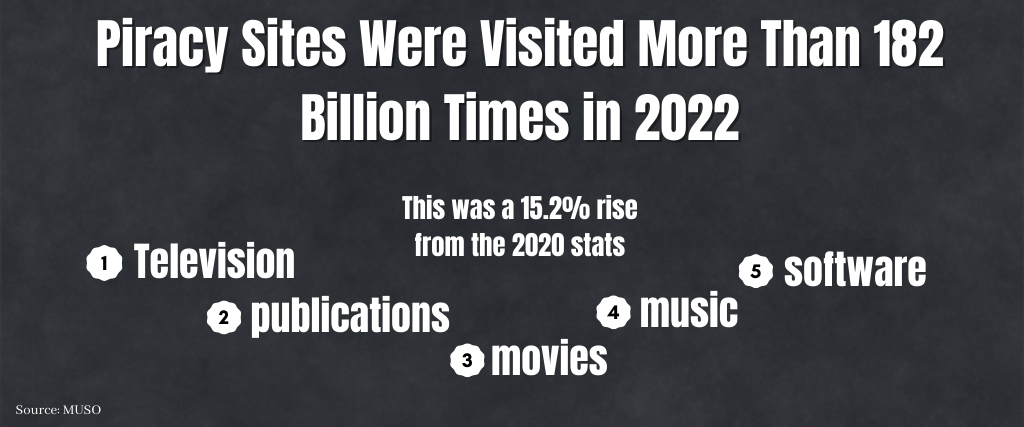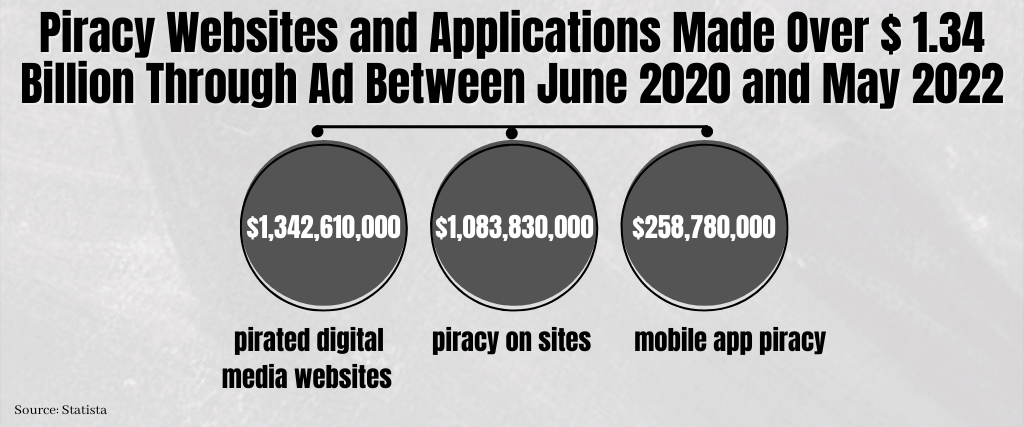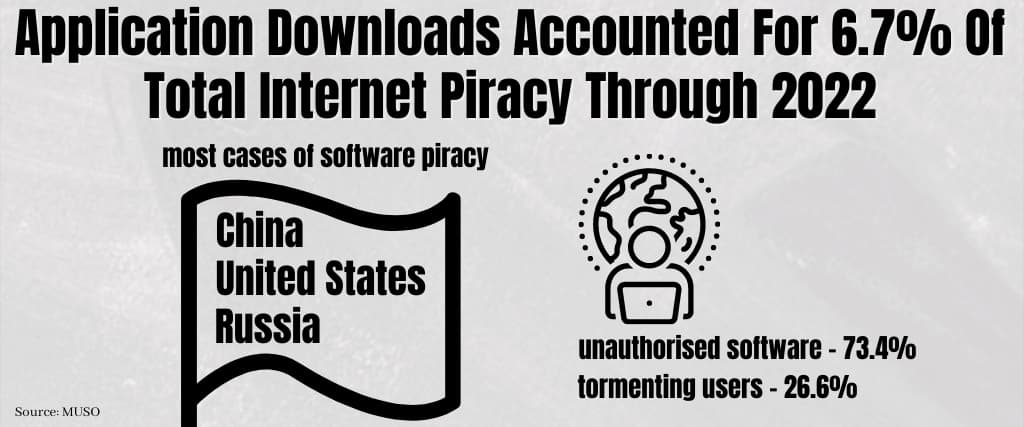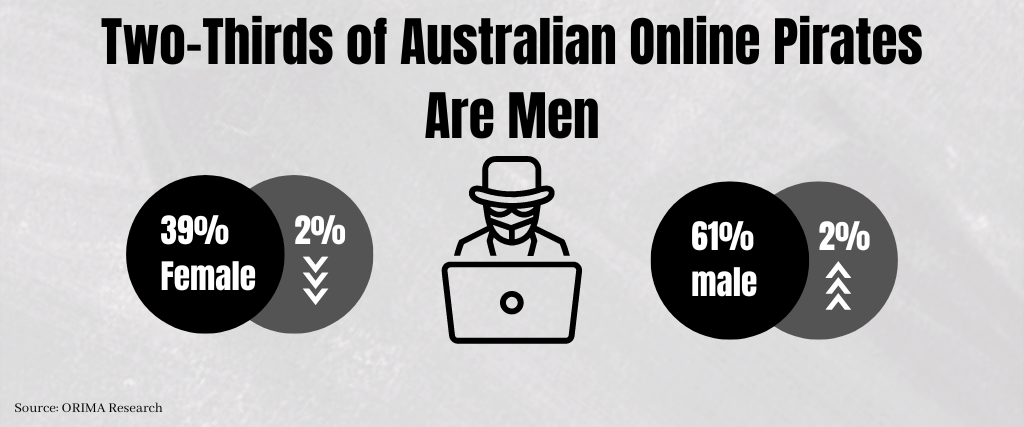Are you eager to dive into the dark seas of downloading and utilising pirated content? If so, then you must also be curious about the number of other people doing it.
This post will introduce you to the most recent data on piracy worldwide, and in Australia, so you don’t have to.
General Statistics on Internet Piracy in Australia and Across the Globe
1. Americans Were the Most Frequent Visitors to Sites With Pirated Content in 2022
- Study by MUSO
In 2022, the United States accounted for 10.6% of all traffic to websites with pirated content. This reflects 68 site visits for every internet user.
This was an increase of 88 percentage points above the Russian Federation, which held the position of second place in the same study. India, China, and Brazil also featured in the top five nations leading in the consumption of pirate materials.

2. Piracy Sites Were Visited More Than 182 Billion Times in 2022
- Study by MUSO
This was a 15.2% rise from the 2020 stats.
Television programmes were the most often copied media material, followed by publications, movies, music, and software.

3. Piracy Websites and Applications Made Over $ 1.34 Billion Through Ad Between June 2020 and May 2022
- Study by Statista
The advertising income produced by pirated digital media websites and apps throughout the globe is estimated to have been $ 1,342,610,000 in only one year.
Over $1,083,830,000 came from piracy on sites, while mobile app piracy contributed about $258,780,000. Interestingly, big brands contributed 4% to the websites’ revenue and 24% to the apps’ ad income. Fraud and malware accounted for 8% and 11% of that money, respectively.
Forms of Piracy

4. TV Shows Contributed Over 50.3% Of Pirate Site Traffic in 2022
In the year 2022, there were over 91.6 billion visits made to websites that illegally gave access to television material such as anime, series, and live sporting events.
Streaming content obtained illegally accounted for over 95.4% of such visits, and the debut season of L0ki was the most sought-after programme.
5. In 2022, 23.7% Of Unauthorised Downloads Were Publishing Piracy
- study by MUSO
Websites with non-fiction, fiction, instructional resources, newspapers, Manga, and magazine content had over 42 billion visits, the second most visited by users all over the globe.
People from the United States, Russia, and Japan were the most frequent visitors to such sites. Visitors from Japan accounted for around 63% of the total volume of traffic that was observed for publication piracy.

6. Piracy Movie Sites Accounted For Over 11% Of Unauthorised Site Traffic in 2022
- Stats by MUSO
In 2022, there were over 20.3 billion visits to film piracy sites.
To be more specific, 52.2% of users utilised illegal movie streaming services. On the other hand, about 23.4% used illegal online downloads, and 22.4% used public torrent websites.
Venom was the most pirated movie in 2022
7. In 2022, About 8.15% Of Pirate Site Users Accessed Music Through Them
- Data by MUSO
Stream-ripping websites, which allow users to download audio from YouTube videos, were the source of 39.1% of these visits in 2022.
In addition, 31.4% of the traffic contributed by music piracy originated through unlawful streaming, online downloads generated 24.2%, and torrents generated about 5%.

8. Application Downloads Accounted For 6.7% Of Total Internet Piracy Through 2022
- Data by MUSO
China, the United States, and Russia led the pack as the nations with the most cases of software piracy in the year 2022.
Simply downloading unauthorised software from web pages onto devices accounts for over 73.4% of the total, while tormenting users account for the remaining 26.6%.
Australian Piracy Stats
9. In 2022, 30% Of Australians Illegally Consumed Online Content
- data by ORIMA Research
A poll conducted in 2022 found over 71% of respondents had engaged in some kind of media consumption in the three months before the study’s administration. About 68% of respondents had streamed material, 25% downloaded content, and 11% shared online materials.
Now, 43% of this material was obtained in Australia in whole or part via possibly illegal downloads. On the other hand, 24% of such content was obtained through illicit streaming.
10. Does Piracy Concern Australians?
- Data by ORIMA Research
Over 29% of Australians reported having a high confidence level in determining whether or not a piece of internet media is illegal.
Since the epidemic, 14% of people said they were more bothered about whether or not their consumption was legal. This number increased to 28% among infringers and 9% among non-infringers.

11. About 28% Of Aussies Buy Digital Video Content to Avoid Illicit Activities
- Data by Acclaim Mag & Statista
According to a 2022 study, three out of ten Australian adults pay for digital video to avoid piracy activities.
This was the same for 22% of cable and satellite TV customers and 30% of those who had paid for digital music material or podcasts.
In addition, a poll by the Australian consumer organisation found that more individuals in Australia subscribe to streaming services, which has led to a decrease in the number of people downloading television programmes.
12. 11% of Australians visited prohibited sites in 2022
- Data by ORIMA Research & Go To Court Lawyers
The rules governing internet piracy in Australia were updated and strengthened in 2018. This makes it possible for copyright owners to demand that search engine providers remove websites that make money by illegally sharing media content.
As a result, it should not come as a surprise if around one in ten Australians came upon such a site in the year 2022. Over 59% of these individuals just gave up trying to access the information, while 18% looked for an alternative that was still lawful to do so.
13% more people could get around the block, while 5% found a way to obtain it illegally and for free via another channel.
Demographic Stats of Australian Infringers

13. Two-Thirds of Australian Online Pirates Are Men
- Data by ORIMA Research
A glimpse into the demographic split of infringers in 2022 reveals that over 61% were male, a 2% increase from the previous year. Female perpetrators accounted for the remaining 39%, a 2% decrease from the last year.
14. In 2022, Australians Between 16 to 24 Years Were Most Likely to Consume Pirated Content Online
- Data by ORIMA Research
The highest rate of stealing digital content was found among young adults (16 to 24 years, at 22%), followed by those people from 25 to 34 years, at 20%.
In addition, infringers in Australia between the ages of 35 and 44 made up 18% of the total. People above the age of 55 and above made up 15%.
Teenagers from 12 to 15 years and adults between 45 to 54 contributed the lowest number of piracy site visitors, 12%.
15. Online Content Is Most Unlawfully Accessed by Australians Earning Over $80,000
- ORIMA Research
Surprisingly, persons in the highest income category acknowledged the most significant piracy rates in 2022, accessing unauthorised files and streaming at 42% each.
25% of Aussies with income between $40,000 and $80,000 also used online pirates. Australians earning $40,000 and below accounted for 26% of this category.
16. Online Piracy Was Committed by 35% Of Full-Time Employed Aussies in 2022
- Data by ORIMA Research)
Given that more than one-third of those who pirated it had full-time employment, the problem is not one of not being able to purchase the material.
Students were the next cohort most likely to engage in these behaviours, with over 21% of them doing so. The next group, 16%, was the paid part-time or informally employed, and finally, retirees with roughly 10%.
Just 8% of those who were jobless and searching for employment, and 6% of those who weren’t looking for work. Only 3% of self-employed people turned to illegal websites to get a job.
Bottom Line
For a long time, customers have complained that cable bundles force them to spend too much money for too many channels they rarely use. Since then, there has been an increase in legitimate streaming services, but data shows that piracy is still an issue.